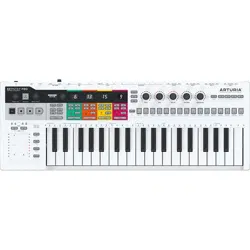Loading ...
Loading ...
Loading ...

1.4.2. Arpeggiator improvements
1.4.2.1. Record an arpeggio into the sequencer
This new feature enables you to record an arpeggio in the sequencer on the same track. It
works like this:
• Select a track (2, 3 or 4) and set it to Arpeggio mode
• Select an empty pattern in this track
• Set Mode to Poly ('Shift'+ Poly)
• Deselect overdub so it's off (to get a better idea of what's happening)
• Start the Arpeggiator (press Play)
• Press record, hold down a chord to start an arpeggio.
Now, simply press the sequencer button on the same track to activate the sequencer and
start playing back the recorded arp.
All 'Shift' edit options are now available to further edit the sequence.
1.4.2.2. Apply Swing to an arpeggio
Swing can now be applied to arpeggios. Turning the Swing knob will apply swing to all
arpeggios simultaneously. Use 'Shift' + Swing to apply swing to the arpeggio on the active
track only. When you record an arpeggio and quantize is off, Swing is recorded in the
sequencer.
1.4.2.3. Play an arpeggio when the sequencer is stopped
It's no longer necessary to start the sequencer playback to be able to 'Play' an arpeggio. An
arpeggio will run whenever you hold down keys.
1.4.2.4. Arpeggiator Velocity is now bipolar
The velocity value of notes playing in an arpeggio can now be changed in real time. When
the velocity encoder is at '0', all notes in the arpeggio will play with the velocity registered
when you pressed the key. Turning the encoder to the right will add to this velocity until a
maximum of 127 is reached. Turning the encoder to the left will subtract from the registered
velocity value. Until, at the -127 point, the note goes silent.
6 Arturia - User Manual Keystep Pro - Welcome and introduction
Loading ...
Loading ...
Loading ...
